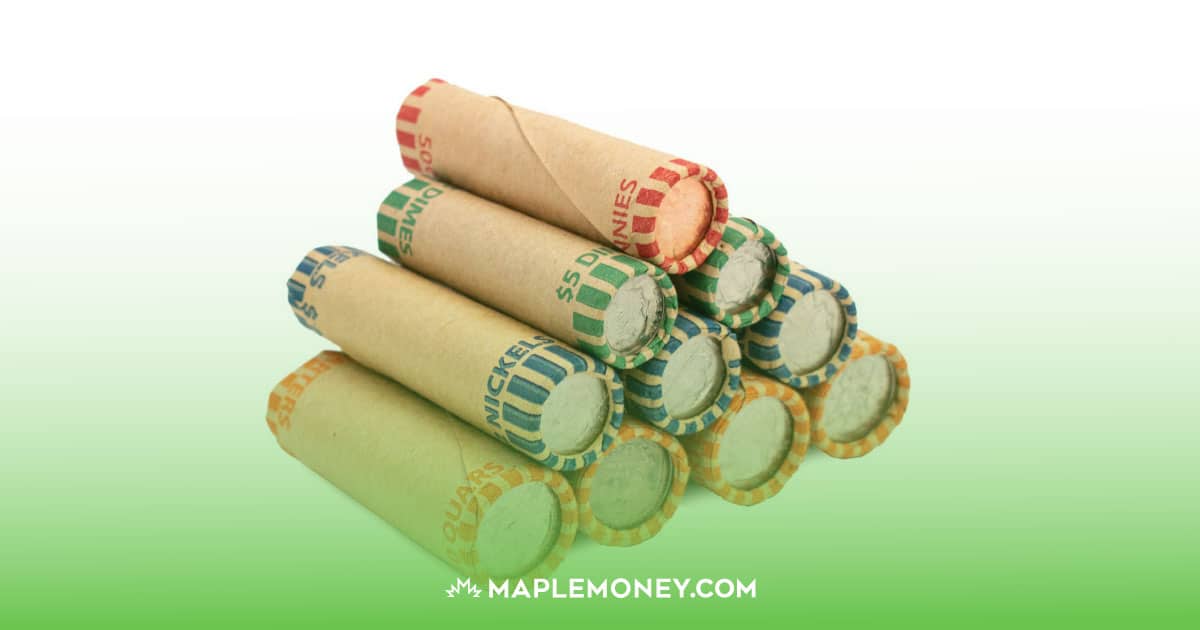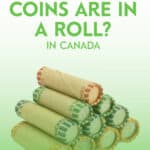How Many Coins Are in a Roll in Canada?

Coin rolls are still the easiest way to organize and transport large amounts of loose change. But with six different coin denominations, including pennies, it can be difficult to remember how many coins are in each type of roll unless you work at a bank or maybe a grocery store
From pennies to toonies, the number of coins in a roll varies based on the coin’s size and value. In this article, I’ll tell you how many coins are in different rolls and how much each roll is worth. This way, you’ll be well-prepared when it’s time to empty that coin jar and take it to the bank.
| Roll | Number of Coins | Value |
|---|---|---|
| Toonies | 25 | $50 |
| Loonies | 25 | $25 |
| Quarters | 40 | $10 |
| Dimes | 50 | $5 |
| Nickels | 40 | $2 |
| Pennies | 50 | $0.50 |
How Many Pennies Are in a Roll?
Canadian pennies are no longer being minted, but millions of pennies remain in circulation. Each roll contains 50 pennies, and with every penny being worth one cent, a full roll amounts to 50 cents.
What Happened to Pennies in Canada?
In 2013, the Royal Canadian Mint stopped producing pennies, though they’re still considered legal tender. The reason behind this decision has to do with the total value of the coins when compared to the cost of production.
The production of a penny costs more than its actual face value or one cent. As a result, it wasn’t economically viable for the government to continue minting the copper-colored coins.
With the elimination of pennies, transactions in Canada began to rely primarily on other Canadian coins. For instance, you have nickels, dimes, quarters, loonies, and toonies in circulation. The values of these coins make transactions smoother compared to the one-cent denomination.
If you have pennies sitting in jars at home, you can still deposit them at any local bank or credit union. Financial institutions are responsible for removing any pennies they receive from circulation and sending them to the Bank of Canada.
How Many Nickels Are in a Roll?
Since 1937, the beaver has been featured on the reverse side of the Canadian nickel, giving it a unique and recognizable design. A roll of nickels consists of 40 coins. Each nickel has a value of 5 cents, which means that a roll of nickels has a total worth of $2. In Canada, paper nickel rollers usually have a navy blue color to distinguish them from other coin roller denominations.
How Many Dimes Are in a Roll?
A standard roll of dimes contains 50 dimes for a total of $5.00. In Canada, most paper dime rollers have a green color to make them easily identifiable. Canadian dimes are made of nickel and are quite thin compared to other coins. This allows 50 dimes to fit into a single roll without taking up too much space.
How Many Quarters Are in a Roll?
In Canada, a roll of quarters contains 40 coins. and each roll is valued at $10 (since each quarter is worth $0.25.) Note that most paper quarter rollers come in an orange colour. Because quarters are larger than dimes or nickels, it means that quarter rolls are also heavier than those denominations.
How Many Loonies Are in a Roll?
The Canadian Loonie is a one-dollar coin that was introduced in circulation in 1987. The gold-coloured coin, which portrays a common loon on its front face, was nicknamed “the Loonie” shortly after it was released. There are 25 coins in a roll of loonies. Because each loonie is worth $1, each roll has a total value of $25 dollars.
Loonies are an essential part of the Canadian currency system and are widely used for everyday transactions. These dollar coins are not only convenient for paying for items at stores but also helpful for budgeting and saving. Typical paper loonie rolls are coloured black as a distinguishing feature. The loonie is produced in Winnipeg by The Canadian Mint.
How Many Toonies Are in a Roll?
A roll of toonies contains 25 coins for a value of $50 for a full roll. The toonie is Canada’s $2 coin. It was introduced in 1996 as a replacement for the two-dollar paper bill. In 2012, the Canadian Mint added new security features to the toonie and loonie coins, along with design changes. A paper toonie wrapper is commonly coloured red or purple, depending upon the manufacturer.
Do Banks Accept Loose Change?
Canadian banks will accept moderate amounts of loose change. However, if you have a lot of loose change, they will usually ask you to roll the coins at home before bringing them to the bank to be deposited. Each bank branch may have different policies around the amount of loose coins they will accept, so it’s best to check with your bank before bringing in significant amounts of loose change.
Some financial institutions may offer coin-counting machines, making it easy to have your coins counted quickly. These machines are designed to sort and count your change efficiently. Before you head to your bank, call ahead and confirm if they have a coin-counting machine and whether there are any fees for using it.
Where Can I Get Empty Coin Wrappers for Rolling Coin?
You can usually purchase empty coin wrappers from any dollar store, but you can also pick them up for free at your local bank. Make sure you get the proper rollers for the denominations that you plan to roll.
Another option is to purchase empty coin rollers online through Amazon or a similar marketplace. However, the prices tend to be quite expensive and not worth it if you can easily get them from a local bank free of charge.
What Are Coin Wrappers Made of?
Coin wrappers, or rollers, are made of either paper or plastic. Paper wrappers are most common and are colour-coded to indicate the denomination the wrapper is designed for, e.g., nickels, dimes, quarters, etc. Plastic wrappers are usually not colour-coded, but are clear, so you can easily see the coins inside the wrapper.
Where Can You Get Rolled Coins?
You may find yourself in a situation where you need access to large amounts of loose change. For example, you may need it for a float for a yard sale or a charity BBQ you’ve organized.
The best place to get rolled coins is from your local bank or credit union, which always keeps a certain amount of coins on hand. However, if you need a very large amount of a specific denomination, it’s a good idea to call ahead to ensure it’s available. This also allows your bank to prepare your coin in advance, so it’s ready for you when you arrive.
Some large retailers, such as grocery stores or supermarkets, may offer rolled coins to customers who need them in exchange for paper bills. You can inquire at the customer service desk to see if this is a service they offer.
Can Rare Canadian Coins Be Rolled?
You can roll pennies, nickels, dimes, quarters, loonies, and toonies. If you have a rare Canadian coin of any denomination, I don’t recommend including it in a roll with regular coins, as you won’t be able to exchange it for its proper value. You may be able to sell or exchange your rare coins through a coin dealer who can compensate you for the fair market value of your coin.
Final Thoughts
Dealing with rolled coins is pretty straightforward, but it always helps to know how many coins you need to roll for the different denominations and how much each type of coin roll is worth.
There’s one more important thing you should know about depositing rolled coins in Canada.
Many Canadians find U.S. coins in with their Canadian loose change and wonder if they can exchange them for Canadian currency. After all, the U.S. dollar is worth significantly more than the Canadian dollar, so you would come out ahead if you could convert your U.S. change.
Unfortunately, Canadian banks accept U.S. coins at face value and won’t do a currency exchange for you, even if you’ve rolled your U.S. coins. They only perform a foreign exchange for paper bills.
If you regularly come across U.S. coins, you may want to consider saving them up and using them on your next trip south of the border. You will have the option of spending them as U.S. currency or exchanging them for U.S. paper bills, which you can exchange for Canadian when you return.
FAQs
How many quarters are in a $10 roll?
There are 40 quarters in a $10 roll of Canadian quarters. Each quarter is worth 25 cents, so when you have a roll of 40 quarters, the total value adds up to $10. Quarters are commonly used for vending machines or self-service car washes.
How many 5-cent coins are in a Canadian roll?
A Canadian roll of 5-cent coins, also known as nickels, contains 40 coins. The total value of these 40 nickels is $2.00, with each nickel being worth 5 cents.
Do Canadian banks accept rolled coins?
Yes, all Canadian banks accept rolled coins. In fact, if you have a lot of coins, they may require that you roll them at home before bringing them to the bank, as rolling coins can be time-consuming and not practical to do at the bank teller.

